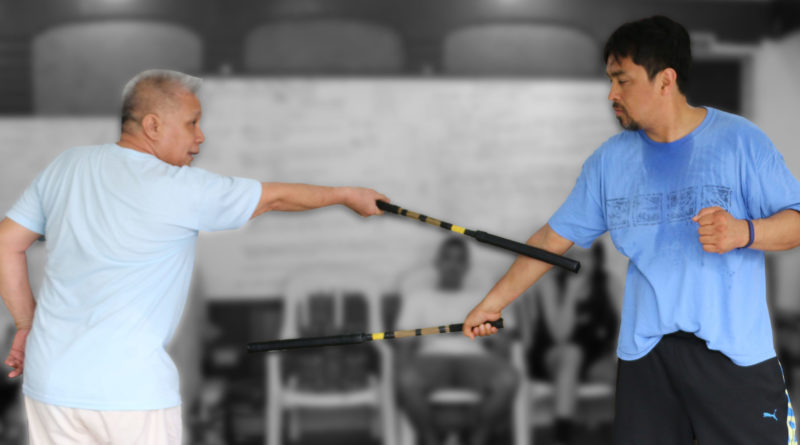Distance, Timing, and Controlling the Center Line in the Ilustrisimo System
The fighting system of the late Grandmaster Antonio “Tatang” Ilustrisimo is one of the most revered systems in all of FMA. Its fame is based on both the untarnished reputation of its Grandmaster and the skills of his numerous students, many of whom have become respected Eskrima masters in their own right.
Tatang belongs to that generation of Eskrimadors who still relied on their martial skills to literally defend themselves. Because of this, they were not too keen on teaching what they knew and did not have an organized curriculum of instruction. Instead, lessons under these Grandmasters were more “fluid” where they would simply counter an attack and it was up to the student to absorb what he could. As a result, many of Tatang Illustrisimo’s first-generation students have their own interpretation of the deadly art based on their own understanding and analysis, physicality, and whatever insight directly shared to them by the Grandmaster.
Romeo C. Macapagal, or “Mang Romy” to his students, is one such Master who learned directly from Tatang. Although his first exposure to Eskrima was from his paternal Grandfather when he was just a boy, he studied intensively under Ilustrisimo for more than a decade during the time when Tatang was still extremely active. Apart from his love of Eskrima, Mang Romy is also a student of History who has observed and recognized the many cultural influences found within the Ilustrisimo system. “The sword movement of Ilustrisimo is possibly 75% Spanish, but the knife work of Ilustrisimo is pure Silat,” he explains. When I asked him how he would best describe the Ilustrisimo system, he automatically replies that “Ilustrisimo, by virtue of the character of Bantayan [being a melting pot of cultures and as the first line of defense against raiding pirates] was a pure fighting art from the very beginning.”
One of the aspects of the Ilustrisimo system Mang Romy is very particular on is that of “measure”—something which he says Tatang greatly emphasized. In his lessons, Mang Romy would focus on very specific body mechanics to gain the slightest advantage over his opponent emphasizing a level of precision found in very few other systems in FMA. Intrigued, we humbly asked him to explain some of its finer points.
Olisi: Could you break down the Ilustrisimo guard stance and explain how its structure helps in controlling the distance/range of combat
Mang Romy: The basic guard stance places the right foot forward [if you are right handed] with the front knee slightly bent. The back leg is straight because the first reaction is a backward movement of the lead foot. Which means you have to use your left foot as a base so you can swing the right foot back like a pendulum. It’s a very fast backward movement because physiologically, the backward movement of primates [especially humans] is faster than a forward movement. That is why you can catch up with an attack coming forward at you when you swing back. However, John Silver [of England], explains that the second backward movement is not as fast so you have to have the technique. You strike at the same time you are struck, but by managing the distance you avoid getting hit while still being able to counter.
The weapon hand in guard is unlike other systems who go on a serrada guard, we prefer the saber guard. The weapon is vertical, the forearm is parallel to the ground, the elbow is tucked into the floating ribs. The forearm, the upper arm, and the shoulder are on one plane. So that if your hand or arm is attacked, you can deflect the attack with a flick of the wrist, or you can simply pull back.
Olisi: Would it be correct to say then that the first instinct is to defend?
Mang Romy: No, incorrect. The idea of Tatang was to attack the attack. Attack the defense, attack the guard. It is a very aggressive system. Practically every FMA system hits the stick, to stop the stick. In Ilustrisimo, you avoid the stick and hit at the same time. And that is where the measure comes in.
Olisi: Can you explain the concept of praksyon?
Mang Romy: In Ilustrisimo praksyon simply means that when you are being fed [strikes] 1-2-3-4, at the later stages, the patterns are broken up/randomized 3-2-4-1, etc. This is done so you do not get used to a particular (predictable) pattern.
Olisi: Whenever you teach, you seem to emphasize controlling the center line which is not something we see discussed very much in other FMA systems. Could you please explain why you feel this is important?
Mang Romy: You use the center line as a reference point. The best way of getting your weapon to your opponent is to go in 15 degrees off the center line [either left or right]. You don’t go directly to the center line. Instead, you move slightly off. The 15 and 30-degree angles, the tercias, are very much observed in Ilustrisimo. Even the edge on edge contact of the blade is done when you are 30 degrees off your opponent so that the edges do not bite into each other.
Olisi: How do you use engganyo to bridge the gap and enter your opponent’s defense?
Mang Romy: Engganyo is deliberate. You invite a strike at your arm as a target. As it is taken, you move away and cut, you rotate around the path of your opponent’s strike to counter. There are 12 engganyos corresponding to the 12 strikes. In reality, they are nothing more than left to right, up to down, down to up. It is a very clear study of pressure. Because the main principle of Ilustrisimo is una pulgada, which means that you allow your opponent to miss you by one inch as you counter. You move away from the pressure so that he is short of one inch but your movement is designed so you can actually cut in deeper.
Olisi: We touched a bit on footwork earlier but can you expound on how important footwork is in Ilustrisimo.
Romy Macapagal: Ilustrisimo has a real obsession with measure, which has a lot to do with footwork. Tatang describes his most famous uncle, Melecio Ilustrisimo, who drove a nail into his foot [left foot] in order to be able to practice a specific form of footwork, the walong apak. It is something that I teach very exclusively.
We concluded our short interview with Mang Romy with a bit of training where he showed us in real time how the concepts he was explaining earlier were applied. The Ilustrisimo system is all at once precise, direct, and graceful. And at 72, Mang Romy exhibits a mastery of the art that can only be achieved with careful and consistent study focused on technique and real-world combat application.
The fighting art of Antonio “Tatang” Ilustrisimo continues to live on and is as deadly as it has ever been. Pugay!






My clique on Facebook would love your post. May I pass it on to them?|
When I asked him how he would best describe the Ilustrisimo system, he automatically replies